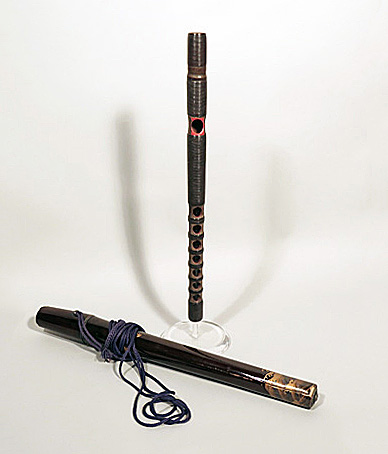
Owner: HWMC
Catalogue #: 2AS-AEBH-17
Edge-blown Flutes
Japan 'Nokan' (Flute)
Japan
Japanese
Bamboo, lacquer, paint, bark
Late 19th century
Length: 15.75 inches
Aerophones – Wind Instruments Proper – Edge-blown Flutes
The nokan or fue’ (flute) is a transverse bamboo flute with 7 finger holes on the front. Inside the bamboo tapering conical bore tube is an interior coating of tempera paint, used to preserve and keep it from cracking. The nokan is also bound with thin lacquered strips of twisted cherry bark (kabamaki). It is played by blowing across the oval embouchure hole on the front that is in-line with the finger holes. The pitch range of the nokan is over two octaves. The nokan is played in the Japanese ‘Noh’ theatre, in addition to Japanese dance music (nagauta), offstage music of the kabuki theatre (geza) and various folk music.
The nokan resembles the ryuteki in many ways, especially from the outer appearance, the bark wrapping, the lacquered bore, and the internal metal weight above the embouchure hole. A major difference and the most distinctive feature is the nodo (‘throat’), a short tube inserted in the bore between the embouchure-hole and the nearest finger-hole of the nokan. According to David W. Hughes, it causes the overblown octave to be sharp at the lower end and flat at the top.
The nokan flute was created by Kan’ami and his son Zeami, while they were transforming the ‘Noh’ theatre forms Dengaku and Sarugaku in the 15th century.
Resource: “Nokan,” David W. Hughes, “The Grove Dictionary of Musical Instruments,” 2nd ed., Laurence Libin, Editor in Chief.
